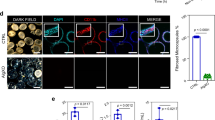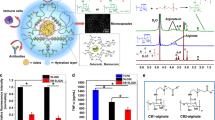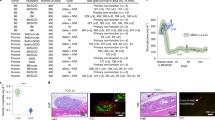Abstract
The transplantation of pancreatic islet cells could restore glycaemic control in patients with type 1 diabetes. Microspheres for islet encapsulation have enabled long-term glycaemic control in rodent models of diabetes; however, humans transplanted with equivalent microsphere formulations have experienced only transient islet graft function owing to a vigorous foreign-body response (FBR), to pericapsular fibrotic overgrowth (PFO) and, in upright bipedal species, to the sedimentation of the microspheres within the peritoneal cavity. Here, we report the results of the testing in non-human primate (NHP) models of seven alginate formulations that were efficacious in rodents, including three that led to transient islet graft function in clinical trials. All formulations elicited significant FBR and PFO 1 month post implantation; however, three chemically modified, immune-modulating alginate formulations elicited a reduced FBR. In conjunction with a minimally invasive transplantation technique into the bursa omentalis of NHPs, the most promising chemically modified alginate derivative (Z1-Y15) protected viable and glucose-responsive allogeneic islets for 4 months without the need for immunosuppression. Chemically modified alginate formulations may enable the long-term transplantation of islets for the correction of insulin deficiency.
This is a preview of subscription content, access via your institution
Access options
Access Nature and 54 other Nature Portfolio journals
Get Nature+, our best-value online-access subscription
$29.99 / 30 days
cancel any time
Subscribe to this journal
Receive 12 digital issues and online access to articles
$99.00 per year
only $8.25 per issue
Buy this article
- Purchase on Springer Link
- Instant access to full article PDF
Prices may be subject to local taxes which are calculated during checkout



Similar content being viewed by others
References
Chang, T. M. Semipermeable microcapsules. Science 146, 524–525 (1964).
Lim, F. & Sun, A. M. Microencapsulated islets as bioartificial endocrine pancreas. Science 210, 908–910 (1980).
Strand, B. L., Coron, A. E. & Skjak-Braek, G. Current and future perspectives on alginate encapsulated pancreatic islet. Stem Cells Transl. Med. 6, 1053–1058 (2017).
Haug, A. & Smidsrod, O. Selectivity of some anionic polymers for divalent metal ions. Acta Chem. Scand. 24, 843 (1970).
Kollmer, M., Appel, A. A., Somo, S. I. & Brey, E. M. Long-term function of alginate-encapsulated islets. Tissue Eng. Part B Rev. 22, 34–46 (2015).
Mooranian, A., Negrulj, R., Arfuso, F. & Al-Salami, H. Characterization of a novel bile acid-based delivery platform for microencapsulated pancreatic beta-cells. Artif. Cells Nanomed. Biotechnol. 44, 194–200 (2016).
Kleinberger, R. M., Burke, N. A., Zhou, C. & Stover, H. D. Synthetic polycations with controlled charge density and molecular weight as building blocks for biomaterials. J. Biomater. Sci. Polym. Ed. 27, 351–369 (2016).
Duvivier-Kali, V. F., Omer, A., Lopez-Avalos, M. D., O’Neil, J. J. & Weir, G. C. Survival of microencapsulated adult pig islets in mice in spite of an antibody response. Am. J. Transplant. 4, 1991–2000 (2004).
Duvivier-Kali, V. F., Omer, A., Parent, R. J., O’Neil, J. J. & Weir, G. C. Complete protection of islets against allorejection and autoimmunity by a simple barium-alginate membrane. Diabetes 50, 1698–1705 (2001).
Omer, A. et al. Long-term normoglycemia in rats receiving transplants with encapsulated islets. Transplantation 79, 52–58 (2005).
Dolgin, E. Diabetes: encapsulating the problem. Nature 540, S60–S62 (2016).
Basta, G. et al. Long-term metabolic and immunological follow-up of nonimmunosuppressed patients with type 1 diabetes treated with microencapsulated islet allografts: four cases. Diabetes Care 34, 2406–2409 (2011).
Calafiore, R. et al. Microencapsulated pancreatic islet allografts into nonimmunosuppressed patients with type 1 diabetes: first two cases. Diabetes Care 29, 137–138 (2006).
Tuch, B. E. et al. Safety and viability of microencapsulated human islets transplanted into diabetic humans. Diabetes Care 32, 1887–1889 (2009).
Jacobs-Tulleneers-Thevissen, D. et al. Sustained function of alginate-encapsulated human islet cell implants in the peritoneal cavity of mice leading to a pilot study in a type 1 diabetic patient. Diabetologia 56, 1605–1614 (2013).
O’Sullivan, E. S., Vegas, A., Anderson, D. G. & Weir, G. C. Islets transplanted in immunoisolation devices: a review of the progress and the challenges that remain. Endocr. Rev. 32, 827–844 (2011).
Qi, M. et al. A recommended laparoscopic procedure for implantation of microcapsules in the peritoneal cavity of non-human primates. J. Surg. Res. 168, e117–e123 (2011).
de Vos, P., Hamel, A. F. & Tatarkiewicz, K. Considerations for successful transplantation of encapsulated pancreatic islets. Diabetologia 45, 159–173 (2002).
Vaithilingam, V. & Tuch, B. E. Islet transplantation and encapsulation: an update on recent developments. Rev. Diabet. Stud. 8, 51–67 (2011).
Desai, T. & Shea, L. D. Advances in islet encapsulation technologies. Nat. Rev. Drug Discov. 16, 338–350 (2017); erratum 16, 367 (2017).
Doloff, J. C. et al. Colony stimulating factor-1 receptor is a central component of the foreign body response to biomaterial implants in rodents and non-human primates. Nat. Mater. 16, 671–680 (2017).
King, A., Sandler, S. & Andersson, A. The effect of host factors and capsule composition on the cellular overgrowth on implanted alginate capsules. J. Biomed. Mater. Res. 57, 374–383 (2001).
Phillips, K. A. et al. Why primate models matter. Am. J. Primatol. 76, 801–827 (2014).
Mestas, J. & Hughes, C. C. Of mice and not men: differences between mouse and human immunology. J. Immunol. 172, 2731–2738 (2004).
Messaoudi, I., Estep, R., Robinson, B. & Wong, S. W. Nonhuman primate models of human immunology. Antioxid. Redox Signal. 14, 261–273 (2011).
Vegas, A. J. et al. Combinatorial hydrogel library enables identification of materials that mitigate the foreign body response in primates. Nat. Biotechnol. 34, 345–352 (2016).
Veiseh, O. et al. Size- and shape-dependent foreign body immune response to materials implanted in rodents and non-human primates. Nat. Mater. 14, 643–651 (2015).
Morch, Y. A., Donati, I., Strand, B. L. & Skjak-Braek, G. Effect of Ca2+, Ba2+, and Sr2+ on alginate microbeads. Biomacromolecules 7, 1471–1480 (2006).
Qi, M. et al. Encapsulation of human islets in novel inhomogeneous alginate-Ca2+/Ba2+ microbeads: in vitro and in vivo function. Artif. Cells Blood Substit. Immobil. Biotechnol. 36, 403–420 (2008).
Morch, Y. A. et al. Binding and leakage of barium in alginate microbeads. J. Biomed. Mater. Res. A 100, 2939–2947 (2012).
Rokstad, A. M., Lacik, I., de Vos, P. & Strand, B. L. Advances in biocompatibility and physico-chemical characterization of microspheres for cell encapsulation. Adv. Drug Deliv. Rev. 67–68, 111–130 (2014).
Anderson, J. M., Rodriguez, A. & Chang, D. T. Foreign body reaction to biomaterials. Semin. Immunol. 20, 86–100 (2008).
Kolb, M. et al. Differences in the fibrogenic response after transfer of active transforming growth factor-beta1 gene to lungs of “fibrosis-prone” and “fibrosis-resistant” mouse strains. Am. J. Respir. Cell Mol. Biol. 27, 141–150 (2002).
Vegas, A. J. et al. Long-term glycemic control using polymer-encapsulated human stem cell-derived beta cells in immune-competent mice. Nat. Med. 22, 306–311 (2016).
Towell, M. E., Lysak, I., Layne, E. C. & Bessman, S. P. Tissue oxygen tension in rabbits measured with a galvanic electrode. J. Appl. Physiol. 41, 245–250 (1976).
Klossner, J., Kivisaari, J. & Niinikoski, J. Oxygen and carbon dioxide tensions in the abdominal cavity and colonic wall of the rabbit. Am. J. Surg. 127, 711–715 (1974).
Goh, F., Long, R. Jr, Simpson, N. & Sambanis, A. Dual perfluorocarbon method to noninvasively monitor dissolved oxygen concentration in tissue engineered constructs in vitro and in vivo. Biotechnol. Prog. 27, 1115–1125 (2011).
Christoffersson, G. et al. Clinical and experimental pancreatic islet transplantation to striated muscle: establishment of a vascular system similar to that in native islets. Diabetes 59, 2569–2578 (2010).
Toso, C. et al. Effect of microcapsule composition and short-term immunosuppression on intraportal biocompatibility. Cell Transplant. 14, 159–167 (2005).
Dufrane, D. et al. The influence of implantation site on the biocompatibility and survival of alginate encapsulated pig islets in rats. Biomaterials 27, 3201–3208 (2006).
Veriter, S. et al. In vivo selection of biocompatible alginates for islet encapsulation and subcutaneous transplantation. Tissue Eng. Part A 16, 1503–1513 (2010).
Liu, X. Y., Nothias, J. M., Scavone, A., Garfinkel, M. & Millis, J. M. Biocompatibility investigation of polyethylene glycol and alginate-poly-L-lysine for islet encapsulation. ASAIO J. 56, 241–245 (2010).
Yang, K. C. et al. Comparison of bioartificial pancreas performance in the bone marrow cavity and intramuscular space. Arch. Med. Res. 41, 151–153 (2010).
Kobayashi, T. et al. Survival of microencapsulated islets at 400 days posttransplantation in the omental pouch of NOD mice. Cell Transplant. 15, 359–365 (2006).
Pareta, R. et al. Long-term function of islets encapsulated in a redesigned alginate microcapsule construct in omentum pouches of immune-competent diabetic rats. Pancreas 43, 605–613 (2014).
Robles, L., Storrs, R., Lamb, M., Alexander, M. & Lakey, J. R. Current status of islet encapsulation. Cell Transplant. 23, 1321–1348 (2014).
Zhu, H. et al. Selection of implantation sites for transplantation of encapsulated pancreatic islets. Tissue Eng. Part B Rev. 24, 191–214 (2018).
Pepper, A. R. et al. A prevascularized subcutaneous device-less site for islet and cellular transplantation. Nat. Biotechnol. 33, 518–523 (2015).
Stokes, R. A. et al. Transplantation sites for human and murine islets. Diabetologia 60, 1961–1971 (2017).
Olsson, R. & Carlsson, P. O. A low-oxygenated subpopulation of pancreatic islets constitutes a functional reserve of endocrine cells. Diabetes 60, 2068–2075 (2011).
Avgoustiniatos, E. S. & Colton, C. K. Effect of external oxygen mass transfer resistances on viability of immunoisolated tissue. Ann. NY Acad. Sci. 831, 145–167 (1997).
Nourmohammadzadeh, M. et al. Microfluidic array with integrated oxygenation control for real-time live-cell imaging: effect of hypoxia on physiology of microencapsulated pancreatic islets. Anal. Chem. 85, 11240–11249 (2013).
Kim, W. H. et al. Exposure to chronic high glucose induces beta-cell apoptosis through decreased interaction of glucokinase with mitochondria: downregulation of glucokinase in pancreatic beta-cells. Diabetes 54, 2602–2611 (2005).
Biarnes, M. et al. β-cell death and mass in syngeneically transplanted islets exposed to short- and long-term hyperglycemia. Diabetes 51, 66–72 (2002).
Vallabhajosyula, P. et al. Effect of the diabetic state on islet engraftment and function in a large animal model of islet-kidney transplantation. Cell Transplant. 26, 1755–1762 (2017).
Mueller, K. R. et al. Differences in glucose-stimulated insulin secretion in vitro of islets from human, nonhuman primate, and porcine origin. Xenotransplantation 20, 75–81 (2013).
Qi, M. et al. Implementation of a simplified method of islet isolation for allogeneic islet transplantation in cynomolgus monkeys. Pancreas 43, 226–235 (2014).
Qi, M. et al. Five-year follow-up of patients with type 1 diabetes transplanted with allogeneic islets: the UIC experience. Acta Diabetol. 51, 833–843 (2014).
Gangemi, A. et al. Islet transplantation for brittle type 1 diabetes: the UIC protocol. Am. J. Transplant. 8, 1250–1261 (2008).
Adewola, A. F. et al. Microfluidic perifusion and imaging device for multi-parametric islet function assessment. Biomed. Microdevices 12, 409–417 (2010).
Keizer, J. & Magnus, G. ATP-sensitive potassium channel and bursting in the pancreatic beta cell. A theoretical study. Biophys. J. 56, 229–242 (1989).
Klingberg, F., Hinz, B. & White, E. S. The myofibroblast matrix: implications for tissue repair and fibrosis. J. Pathol. 229, 298–309 (2013).
Sheikh, Z., Brooks, P. J., Barzilay, O., Fine, N. & Glogauer, M. Macrophages, foreign body giant cells and their response to implantable biomaterials. Materials 8, 5671–5701 (2015).
Wynn, T. A. & Vannella, K. M. Macrophages in tissue repair, regeneration, and fibrosis. Immunity 44, 450–462 (2016).
Mantovani, A., Biswas, S. K., Galdiero, M. R., Sica, A. & Locati, M. Macrophage plasticity and polarization in tissue repair and remodelling. J. Pathol. 229, 176–185 (2013).
Vaithilingam, V. et al. Beneficial effects of coating alginate microcapsules with macromolecular heparin conjugates-in vitro and in vivo study. Tissue Eng. Part A 20, 324–334 (2014).
Kayaalp, C. Bursectomy at radical gastrectomy. World J. Gastrointest. Surg. 7, 249–253 (2015).
Acknowledgements
This work was supported jointly by the Chicago Diabetes Project and the JDRF and the Leona M. and Harry B. Helmsley Charitable Trust (grant number 3-SRA-2014-285-M-R (R.L. and D.G.A.)), the US National Institutes of Health (grant numbers DK091526 (J.O.) EB000244 (R.L.), EB000351 (R.L.), DE013023 (R.L.), CA151884 (R.L.) and UC4DK104218 (D.L.G.)), and through a gift from the Tayebati Family Foundation (D.G.A. and R.L.). This work was also supported by the Slovak Research and Development Agency under contract number APVV-14-858 (I.L.). O.V. was supported by JDRF and Department of Defense Congressionally Directed Medical Research Program (DOD/CDMRP) postdoctoral fellowships (grant numbers 3-2013-178 and W81XWH-13-1-0215, respectively). J.C.D. was supported by a JDRF postdoctoral fellowship (grant number 3-PDF-2015-91-A-N). The authors acknowledge L. Halliday and the veterinary staff at the Biological Resource Laboratories at UIC for their assistance and technical support during the course of the studies. We thank R. Calafiore and G. Basta from the University of Perugia for producing the A-PLO-A spheres under current good manufacturing practice conditions at the University of Illinois at Chicago for the herein described experiments. We thank B. Tuch and his team at the Diabetes Transplant Unit, Prince of Wales Hospital, Sydney, Australia, for the production of the UPMVG-Ba2+ spheres and sharing his experience from the clinical trials in encapsulated islet transplant trials conducted in Sydney, Australia. We thank H. H. Tam for his advice on the statistical analysis of datasets.
Author information
Authors and Affiliations
Contributions
M.A.B., O.V., A.J.V., J.J.M., D.G.A. and J.O. designed the experiments, analysed the data and wrote the manuscript. M.A.B., O.V., A.J.V., J.J.M., M.Q., E.M., M.O., J.C.D., J.M.-E., M.N., A.K., C.-C.Y., Y.X., D.I., S.G., J.L., C.L., A.R.B., K.O., M.C., Y.W. and J.O. performed experiments. J.H.-L., D.L.G., G.C.W., B.L.S., A.M.A.R., I.L. and R.L. provided conceptual advice and technical support. R.L., D.G.A. and J.O. supervised the study. All of the authors discussed the results and assisted in the preparation of the manuscript.
Corresponding authors
Ethics declarations
Competing interests
O.V., A.J.V., R.L., D.G.A. and J.O. are founding scientists of Sigilon Therapeutics, a biotech company based in Cambridge, MA, USA, that produces antifibrotic materials for cell-based therapies. J.O. is founder and President of CellTrans, a biotech company based in Chicago, IL, USA, for the transplantation of cell-based therapies.
Additional information
Publisher’s note: Springer Nature remains neutral with regard to jurisdictional claims in published maps and institutional affiliations.
Supplementary information
Supplementary Information
Supplementary figures and tables
Supplementary Video 1
Non-invasive laparoscopic transplantation technique for hydrogel spheres into the bursa omentalis
Supplementary Video 2
Non-invasive laparoscopic retrieval of Z1-Y15 spheres containing allogeneic islets performed 1-month post-transplantation
Rights and permissions
About this article
Cite this article
Bochenek, M.A., Veiseh, O., Vegas, A.J. et al. Alginate encapsulation as long-term immune protection of allogeneic pancreatic islet cells transplanted into the omental bursa of macaques. Nat Biomed Eng 2, 810–821 (2018). https://doi.org/10.1038/s41551-018-0275-1
Received:
Accepted:
Published:
Issue Date:
DOI: https://doi.org/10.1038/s41551-018-0275-1
This article is cited by
-
Non-viral and viral delivery systems for hemophilia A therapy: recent development and prospects
Annals of Hematology (2024)
-
In vitro oxygen imaging of acellular and cell-loaded beta cell replacement devices
Scientific Reports (2023)
-
Inflammation-induced subcutaneous neovascularization for the long-term survival of encapsulated islets without immunosuppression
Nature Biomedical Engineering (2023)
-
Greater foreign-body responses to big implants
Nature Biomedical Engineering (2023)
-
Single-nucleus multi-omics of human stem cell-derived islets identifies deficiencies in lineage specification
Nature Cell Biology (2023)



